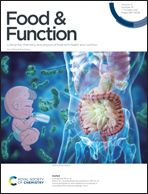N-3 polyunsaturated fatty acids effectively protect against neural tube defects in diabetic mice induced by streptozotocin†
Abstract
Folate cannot prevent all neural tube defects (NTD), indicating that other pathogeneses still exist except for the folate deficiency. Maternal diabetes mellitus during pregnancy can increase the risk of offspring NTD. Our previous study showed that polyunsaturated fatty acids (PUFA) were lower in the placenta of human NTD cases than in healthy controls, and the supplementation of fish oil (rich in long-chain (LC) n-3 PUFA, mainly C20:5n-3 and C22:6n-3) had a better prevention effect against sodium valproate induced NTD than corn oil (rich in C18:2n-6) and flaxseed oil (rich in C18:3n-3). The aim of the present study was to investigate whether PUFA could prevent diabetes-induced NTD in mice. Streptozotocin (STZ)-induced diabetic pregnant mice were fed with a normal diet (DMC), a diet containing a low dose of fish oil (DMLn-3), a diet containing a high dose of fish oil (DMHn-3) or a diet rich in corn oil (DMn-6). Healthy pregnant mice were fed with a normal diet (HC). Compared with the DMC group, the rate of NTD was significantly lower in the DMHn-3 group (4.44% vs. 12.50%), but not in the DMLn-3 (11.11%) or DMn-6 group (12.03%). The NTD rate in the DMHn-3 group was comparable with that in the HC group (1.33%) (p = 0.246), and lower than that in the DMn-6 group (p = 0.052). The NTD rate in DMLn-3 and DMn-6 groups was significantly higher than that in the HC group. No significant difference was observed in NTD rate between DMLn-3 and DMHn-3 groups, and between DMLn-3 and DMn-6 groups. Compared with the HC group, the DMC group had a significantly lower C22:6n-3 in both serum and embryos. Fish oil supplementation ameliorated neuroepithelial cell apoptosis, and the apoptotic rate was comparable between DMHn-3 and HC groups. Although the apoptotic rate was significantly lower in the DMn-6 group than the DMC group, it was still much higher than that in the HC group. The proteins P53 and Bax in embryos were higher, while the proteins Bcl-2 and Pax3 were lower in the DMC group than in the HC group. The disturbance of Pax3, P53 and Bax induced by diabetes was abolished in DMLn-3, DMHn-3 and DMn-6 groups. Importantly, Bcl-2 in embryos was restored to the normal level only in the DMHn-3 group but not in the DMLn-3 or DMn-6 group. In conclusion, LC n-3 PUFA enriched fish oil has a protective effect against NTD in diabetes induced by STZ through improving neuroepithelial cell apoptosis, and the mechanism may be by increasing the anti-apoptosis protein Bcl-2 independently of Pax3 and P53.



 Please wait while we load your content...
Please wait while we load your content...